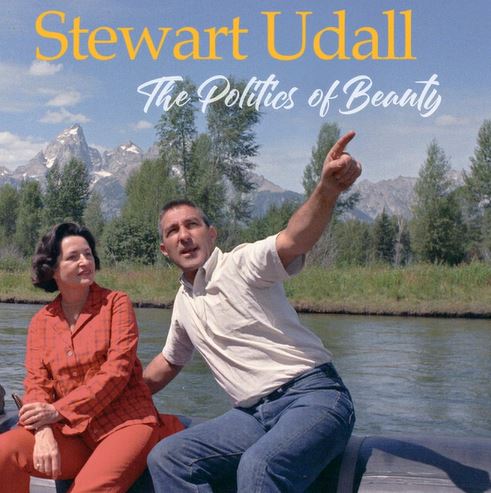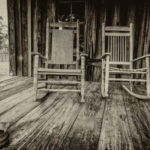[Cross-posted to In Medias Res]
Wichita, KS. John de Graaf, an author, filmmaker, and friend of Front Porch Republic, has recently completed a documentary tribute to a hero of his: Stewart Udall, the pioneering conservationist who in many ways defined (almost entirely for better, though perhaps, in a small way, partly for worse) the environmental agenda of the U.S. government and, more specifically, the Democratic party for the past 60 years. Stewart Udall and The Politics of Beauty is a gorgeously shot and highly informative short movie, a wonderful introduction to a fairly unique and entirely admirable figure from 20th-century American history: a crew-cutted WWII veteran and New Frontier liberal whose passion for the natural world literally changed the landscape of this country–but also an open-minded thinker, a lover of poetry, family, and community, whose conservationist passions led him to be ever more conscious, as the decades went by, of the complications inherent to the liberal statism through which he did his greatest work (even if he never did turn against it entirely). In an essay last year, de Graaf called Udall a “true conservative,” someone who “really wanted to conserve things: land, air, water, beauty, the arts and graces, gentle human relations, the best of tradition, democratic ideals.” This movie reflects that aspect of Udall’s life very well.
Udall’s early history—his birth into the Udall family in 1920 (which was already by then an expanding political clan), his life as a young Mormon in Saint Johns, Arizona, and the poverty, the conflicts, and the fellowship which existed in that arid farming community—is by no means the focus of de Graff’s film, but I was entranced by those opening shots and the story it told, complete with comments from Udall’s surviving siblings. It put me in mind of my own maternal grandfather, Joseph Arben Jolley, who was born just four years before Udall in Tropic, Utah, a similarly remote and tiny Mormon hamlet on the Colorado Plateau (though 300 miles, a couple of mountain ranges, and several Native reservations separate the two towns). Like my grandfather, Udall’s early years were without electricity or running water, something which FDR’s New Deal (specifically the Rural Electrification Act) changed, with radical consequences for the Udall family—among other things, they became Democrats, convinced that government action really can improve human lives.
It was that conviction, tied to his passion for racial and, especially, environmental justice, which shaped his public career, first as an elected representative, and then as Secretary of the Interior under both Presidents Kennedy and Johnson. During those years, Udall orchestrated the establishment of more national parks, historical monuments, wildlife refuges, and recreational areas than any other Interior Secretary either before or since; if you’ve ever visited Canyonlands National Park, or hiked the Appalachian Trail, or spent time at over a hundred other similar locations across America’s beautiful and diverse ecosystems and geography, it’s likely that you have Stewart Udall at least partly to thank. His years of government service were not restricted to what he did to strengthen and expand the conservationist mentality in Washington D.C.; de Graaf’s documentary does an excellent job highlighting Udall’s broad engagement with cultural issues, as well the tensions and frustrations he faced as a leading government official during the heights of the civil rights movement, the Vietnam War, and all the protests both unleashed. But still, it is the lessons he learned in Saint Johns, the way he applied those lessons, the things he learned from his struggles over them, and how his own take on those lessons thus evolved over the decades, which strike me as most valuable to America today.
In 1963, Udall published his first book, The Quiet Crisis. An idiosyncratic and unsystematic but still deeply insightful history of conservation attitudes and efforts throughout American history, its perspective on the role of government in protecting wilderness, particularly in the American West, was in some ways superseded by later books of his. But the original remains something of a lost classic, regularly rediscovered and praised by those trying to understand the development of American society’s relationship to the land. Reading it in conjunction with watching de Graaf’s film both complicates and deepens our understanding of this indefatigable public servant.
In these pages, there are a fair number of embarrassing paeans to the presumed virtue and wisdom of American planners and policy-makers. Among others, the book begins with Udall presenting the national government’s Indian Claims Commission, which is generally understood to have utterly failed in its task to treat Native land claims justly, “as a singular gesture of atonement, which no civilized country has ever matched,” and then towards the conclusion includes some glowing praise for Robert Moses, the devastating over-builder of American cities, highlighting his efforts to “overcome earlier failures to plan” and bring to American urban areas “asphalt for beach parking lots, for playgrounds, and for roads” (pp. 11, 163-164). But between such missteps, there is much worth admiring and pondering.
In The Quiet Crisis, Udall provides thoughtful portraits—and critiques—of influential naturalists, conservationists, and geographers like George Perkins Marsh, Gifford Pinchot, John Wesley Powell, John Muir, and Frederick Law Olmstead. He offhandedly introduces the idea of global warning decades before scientific debates over such crashed into the public consciousness (“What are the long-range results of man’s modification of the environment? When men clear a forest in order to make space for agriculture, how does this clearing affect the climate, the rate of erosion of soil, and the populations of birds and other wild animals?”–p. 81). Predictably, the book includes vicious condemnations of what he variously refers to as the “Big Raid,” the “Great Giveaway,” and the “Myth of Superabundance,” the guiding ideology of many American business interests and monopolists which, facing only occasional resistance, exploited and denuded American forests, ecosystems, watersheds, species, grasslands, resources, and more throughout the 19th century and the first part of the 20th. Perhaps just as predictably, he lavishly praises on those who took executive action on behalf of environmental interests, particularly Presidents Theodore and Franklin Delano Roosevelt. According to Udall, TR “regarded himself as the trustee of the lands owned by the people” and “dared to use his pen,” aggressively expanding the application of the Reclamation Act and the Antiquities Act so as to more than quadruple the size of protected natural lands in the United States (though whether TR’s actions really “dealt a decisive blow to the Myth of Superabundance” in America is doubtful–pp. 131, 136). And in Udall’s view, FDR’s New Deal aimed to reverse effects of “the Big Raids…[during which] much of the nation’s resource capital had been borrowed and used up to advance the personal fortunes of a few”; through the creation of the REA, the Civilian Conservation Corps, the Tennessee Valley Authority, the Soil Conservation Service, and more, the government aimed to “to invest in land-rebuilding programs that would assure adequate resources for tomorrow….[with] the needs of the community and of the next generation…given first priority” (p. 144).
Udall’s reference there to “the needs of the community” may give one pause here, and it should. Because as the aforementioned tendency in The Quiet Crisis to occasionally see national planning as an obvious solution to any environmental or historical or urban problem demonstrates, Udall’s passion for the American landscape and wildlife was not always entirely cognizant of the local people who actually live in those landscapes and with that wildlife. It’s an attitude he clearly struggled with; in The Politics of Beauty, de Graaf shows an excerpt from a 2003 interview with Udall, in which he reflects that “there has always been local opposition, regional opposition, state opposition to the creation of new national parks … because people … wanted to control [the land around them] and do it the way they wanted to do it.” But even 40 years earlier, Udall was, I think, conscious of the ambiguity here. On my reading, the heart of that ambiguity resides with Henry David Thoreau, whom Udall calls “one of our first preservationists” and “a naturalist’s naturalist,” and whom, I believe, haunts his thinking. Consider his criticism of the man’s oeuvre:
Thoreau was alarmed by the Raider spirit, but he failed to realize that the land spoilers were already in command, and were committed to a course of action that would destroy the land values he prized the most. With his negative feelings about government and politics, he failed to perceive that it would take government action to stop the destruction. There were other contradictions: although he abhorred the very thought of social action, land conservation could not begin until men organized for action; he was anti-reformer, but it would take the crusading zeal of reform-minded men to save the woods and wildlife; he was, moreover, the most thoroughgoing nonconformist alive, though the dangerous drift of the time pointed to the need for conformity to minimum rules of resource management. In short, government action was necessary to curb the exploitation of resources and allow the land to renew itself, but Henry David Thoreau was constitutionally and unalterably antiprogram and antigovernment. (p. 52)
To Udall, the results of this disposition were obvious: no national parks, no effective resistance to those would abuse the natural world for their own profit. And yet, consider also Udall’s concluding remarks, in which he looks out the suburbanizing, postwar America he was partly responsible for leading:
We are now a nomadic people, and our new-found mobility had deprived us of a sense of belonging to a particular place. Millions of Americans have no tie to the ‘natural habitat’ that is their home….A land ethic for tomorrow should be as honest as Thoreau’s Walden…. Henry David Thoreau would scoff at the notion that the Gross National Product should be the chief index to the state of the nation, or that automobile sales of figures on consumer consumption reveal anything significant about the authentic art of living. He would surely assert that a clean landscape is as important as a freeway, he would deplore every planless conquest of the countryside, and he would remind his countrymen that a glimpse of a grouse can be more inspiring than a Hollywood spectacular or color television. To those who complain of the complexity of modern life, he might reply, “If you want inner peace find it in solitude, not speed, and if you would find yourself, look to the land from which you came and to which you go. (pp. 189-190)
This ambivalence—leavening what is otherwise a learned and vigorous defense of what Udall clearly understood as a progressive and beneficial fight by experts to tame American individualism and protect America’s natural bounty, most especially in the arid ecosystems of the American West—shouldn’t surprise anyone who sees in Udall the mature wisdom which de Graaf’s movie so ably demonstrates. Udall was a person capable of changing his mind—about the postwar passion for dam-building, most prominently—and of growing and rethinking as the years went by. That growth helped him come to see the foolishness of his support for Cold War policies which have paved the way for American militarism, and to regret his support for energy and highway development projects which have only led to greater urban centralization and pollution. His deep, almost religious commitment to principles of frugality, family, and justice (my sole complaint with de Graaf’s wonderful documentary is that its brief references to Udall’s Mormonism don’t capture the complicated reality of his membership in his and my shared tribe) may have expressed themselves in different ways over the decades, but they surely only grew stronger with time.
It would be too much to say that the work he committed himself to in the decades following his later years—among other things, a long legal struggle to get the national government to acknowledge the harms of the radiation it had exposed thousands to through nuclear testing in the American southwest through the 1950s and 1960s—was something he took on as a penance. On the contrary, it’s unlikely he ever regretted his role in using the power of the national government to accomplish ends which provided great benefits to the broader public, to say nothing of the benefits to the ecosystems which his push for conservation and protecting wilderness areas made possible. But I do think that over the years the ambivalence I sense in his writing–an ambivalence which reflected a frustration with Thoreau’s rejection of collective action, but also an admiration for Thoreau’s committed locality–put him on a somewhat different trajectory. He’s not alone in finding himself struggling over the best balance between the local and the national, or between engaging individual ecological tending and establishing collective ecological boundaries. As I noted years ago, in connection with other contentious acts of national conservation–the Arctic National Wildlife Refuge and Grand Staircase-Escalante National Monument, specifically–Udall’s trajectory has been shared by other Interior Secretaries as well. In an essay he wrote here on Front Porch Republic, Nathan Nielson once spelled out this dynamic well: reflecting upon the protective routinization which the National Park Service provides to America’s beautiful places, Nielson observed that while “local governments have a better sense of what the land means…the federal route is the only viable option when the clamor for nature reaches critical mass.” Indeed.
In a letter Udall wrote to his grandchildren in 2005, Udall had a lot of advice, some of it still quite programmatic and planning oriented, and perhaps defensibly so. But he also brought his mature, reflective perspective to bear on his own part in the ambitious planning of his generation:
Operating on the assumption that energy would be both cheap and superabundant, I admit, led my generation to make misjudgments that have come back and now haunt and perplex your generation. We designed cities, buildings, and a national system of transportation that were inefficient and extravagant. Now, the paramount task of your generation will be to correct those mistakes with an efficient infrastructure that respects the limitations of our environment to keep up with damages we are causing.
Not a fully Thoreau-esque statement, to be sure, but one that is perhaps animated at least in part by his non-comformist, place-loving spirit nonetheless. Sharon Francis, Udall’s longtime aid who knew his work as well as anyone, was extensively interviewed by de Graaf; she called Udall “the Henry David Thoreau of his generation.” Ignoring all the circumstantial ways that comparison doesn’t quite work (to say nothing of the fact that, two generations on from the high point of Udall’s impact sixty years ago, perhaps environmentalism needs less Udallian confidence and more Wes-Jackson-style apocalyptism), and focusing instead on the shared, fundamental passions which make it essentially true, one can’t help but wonder: what better tribute could a true “conservative”—that is, a conserver of the land and the resources which provide human communities and indeed the whole human race with life and joy—possibly receive than that? “The Politics of Beauty” reminds us of this romantic, poetic, but also practical conservation-minded Udall, and that alone is reason to watch it again and again.











3 comments
Brian
Two quick comments:
1. It feels like this topic–development, what a “park” system needs to look like, etc.–for generations now, could use some consideration and thought on the Adirondack model, and what it may or may not bring to the discussion. The Adirondacks is literally about a 50/50 state/private park, and has seemed to manage things pretty darn well for 150+ years (though in recent times things are somewhat shifting due to a combination of rural community collapse and much more anti-human contemporary “environmental” activist groups). It doesn’t have to be a choice between a nationally designated park or a horribly despoiled hellscape, and we don’t have to resort to theoretical discussions, we can look to this actual American example. Perhaps the West is much different, without the same sort of history of human communities embedded into nature, due to the radically different environments of the American Southwest vs the Adirondacks, but perhaps not as much as the historical discussion suggests.
2. Another aspect that comes to my mind is the beauty of the built environment, or the lack thereof in recent times. Sometime shortly after WWII “we” stopped building beautiful buildings, and towns across the country have a classical library down the street from a brutalist nightmare of a town hall and a depressing box of a school built on the edge of down. Somehow the generation that preserved all these open spaces that most people will never see destroyed the beauty that people actually encounter in their everyday lives. (Again, perhaps this is a bit more relevant outside of the American West, where communities don’t have the same age as those east of the Mississippi?)
John Murdock
Readers may appreciate hearing the engaging John de Graaf. He helped us get the Brass Spittoon podcast going and shared stories about the Stewart Udall project:
https://www.frontporchrepublic.com/2021/03/john-de-graaf-affluenza-and-stewart-udall/
Martin
Thanks, Russell, for a wonderfully nuanced review. The 12-minute sampler can be found directly on youtube:
https://www.youtube.com/watch?v=jumddn4nico
I can’t find any info on how long the full version is, but the sampler does include a quote about encouraging more American kids to go outdoors and experience beauty. It’s probably the best way to begin developing a holistic view.
What we often see, unfortunately, are attempts to debate environmental issues on the basis of facts. The old saying is “you can choose your opinions, but you can’t choose your facts” but actually people do choose their facts.
Consider for example reforestation. Satellite imagery is used by environmentalists as well as big corporations to “evidence” acreage of greenery. But satellites only show two dimensions. They fail to portray biomass accurately because they ignore the immense height of primary forests, especially in tropical areas.
Comments are closed.